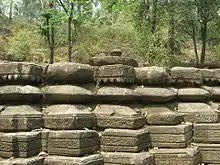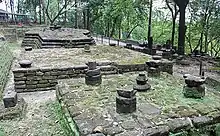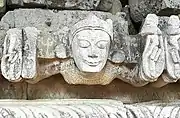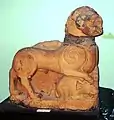Malinithan
Malinithan is an archaeological site which consists of ruins of a Hindu temple of the early medieval period on the northern bank of the Brahmaputra River in the Indian state of Arunachal Pradesh. The archaeological studies of the ruins indicate that the temple was built with granite stones during the period of Hinduism influence in the region. It was built by Chutiya kings in the 13th-14th century.[1][2][3][4][5] This was the period when the Chutiya kings had started setting Brahmins in different areas of their kingdom offering them land grants.[6] Kechai-Khaiti, a Chutia tribal goddess was believed to be the chief deity who was worshipped in the ruined temple. The location of a narrow stream named Akashiganga similar to the site of Tamreswari and Bura-Buri Temples of Sadiya indicates that sacrifices were once performed in the temple.
| Malinithan | |
|---|---|
 Ruins of Malinithan temple | |
| Religion | |
| Affiliation | Hinduism |
| District | Lower Siang district |
| Location | |
| Location | Likabali |
| State | Arunachal Pradesh |
| Country | India |
 Malinithan in Likabali | |
| Geographic coordinates | 27°39′24″N 94°42′21″E |
| Architecture | |
| Creator | Chutia kings |
| Completed | 13th-14th century |

| Part of a series on the |
| History of Assam |
|---|
 |
| Categories |
|
Location
The Malinithan archaeological site is located at the base of the Siang mountains in the Likabali town and a sub-division of the Lower Siang district of Arunachal Pradesh.[6][7] It is situated on a hill that rises to a height of 21 metres (69 ft), which affords a commanding view of the plains around it and of the Brahmaputra River.[8]
Legend
The site was discovered during British Raj times and since then mythology has been fabricated for the site. As per this mythology, it is said that when Krishna wanted to marry Rukmini, the daughter of King Bhishmaka of Vidarbha, he abducted her prior to her wedding with Shishupala. Krishna and Rukmini then travelled from Bhishmakanagar to Dwarka, stopping at Malinithan on the way over, where they were guests of Shiva and Durga, who were doing penance. Parvati, Shiva's consort, warmly welcoming her guests, presented them with garlands made of flowers plucked from her orchard.[6][8] Krishna was so enamoured by the beauty and the scent of the flowers that he addressed Parvati as Malini, meaning "the mistress of the garden", and since then the place is named as Malinithan. In another legend it is said that an image of a female without the head, which was unearthed during the excavations, represented Malini who was the lover of Shiva. The image of the goddess Durga found here is also known as "Pupane", an ancient name for the Divine Mother.
History
The archaeological finds at the site of sculptures of Durga, a Shiva linga and a bull, the mount of Shiva, relate to worship by people of the Shiva cult. Based on these, archaeologists have inferred that the Shakti cult was practised in the region. It was one of the three leading centers of Shaktism; the other two centers are stated to be Bhaghawati, the mother goddess at Gorehoga village in North Lakhimpur, and Harhithan in Dhakuakhana in the west end Tamresari in the east. The temple doesn't find any mention in the 10th-11th century Kalika Purana. From all archaeological evidences at the site, archaeologists have opined that the temple belonged to the 13th century. Stone mason marks found in Malini than[9] were also found in sites of Sadiya like Tamreswari temple, Bura-buri, Padum pukhuri as well as other places like Nakshaparbat and Buroi fort which indicate that all these structures were built by the same people during the same period, i.e. during the reign of Chutia kings.[10][11] It is interesting to note that the marks in the Tamreswari temple were found in the foundation of a brick wall which was built by the Chutia king Muktadharmanarayana in 1442 AD.[12]
Features
The archaeological excavations revealed a very well designed and carved plinth of a temple, of 8 feet (2.4 m) height, sculptures of deities and animals, designs of flowers, damaged columns and panels. Four sculptures of lions on two elephants were found at the four corners of the ruins of the temple.
Among the sculptures found at Malinthan, five notable ones carved out of granite stone are of Indra riding his mount Airavata, Kartikeya riding a peacock, Surya (Sun) riding a chariot, and Ganesha mounted over a mouse, and a large Nandi bull.[8] On the basis of the erotic Maithuna sculptures found here in different postures it is believed that tantricism prevailed here as a fertility rite of the primitive tribal people who held the "mother principal as the procreative power of nature".
The temple is carved entirely out of stone, a type of temple known as Asmamayai. Iron dowels discovered in the ruins of the stone temple which resemble the ones found in the Tamreswari temple of Sadiya shows that it was built by the same people.[13]
Gallery
 Malinithan Mother goddess sculpture
Malinithan Mother goddess sculpture Gaja-singha of Malinithan
Gaja-singha of Malinithan Malinithan Shiva sculpture
Malinithan Shiva sculpture Malinithan Kartika sculpture
Malinithan Kartika sculpture Malinithan Apsara sculpture
Malinithan Apsara sculpture
References
- Sarma, P.C.A study of the temple architecture of Assam from the Gupta period to the end of the Ahom rule: Chutiya architecture, p. 205
- Choudhury, R.D, Heritage of Architecture of Assam, p.5
- (Bose 1997:43)
- Sengupta, Gautam, Archeology in Northeast India, p.359
- Thakur, A.K, Pre-historic Archeological Remains of Arunachal Pradesh and People's perception: An Overview, p.6
- "Malini Than". Government of Arunachal Pradesh. Archived from the original on 12 May 2015. Retrieved 3 May 2015.
- "Likabali". Retrieved 3 May 2016.
- Sali 1998, p. 148.
- Thakur, A.K, Pre-historic Archeological Remains of Arunachal Pradesh and People's perception: An Overview, p.6
- "The probability is that these ruins are the traces of as Hindu or Hinduised dynasty of local rulers who ruled over a kingdom confined to the north bank of Brahmaputra and extending from Burai in the west to Sadiya in the east. This dynasty is evidently the line of Chutia kings who assumed the surname Pala" Barua, K.L An Early History of Kamrupa 1933, p. 271.
- "If architectural continuity is admitted between the fortifications in the Sadiya region and the Burai river ruin site, it would be possible to believe that the kingdom of these rulers extended as far as the outer limit of Darrang district." Neog, Maheswar, Lights on a Ruling Dynasty of Arunachal Pradesh, p.218
- Hannay, S.F, Journal of the Asiatic society of Bengal 1848, p.467.
- Religious History of Arunachal Pradesh by Byomakesh Tripathy, p.354
Bibliography
- Sali, M. L. (1 January 1998). India-China Border Dispute: A Case Study of the Eastern Sector. APH Publishing. ISBN 978-81-7024-964-1.CS1 maint: ref=harv (link)